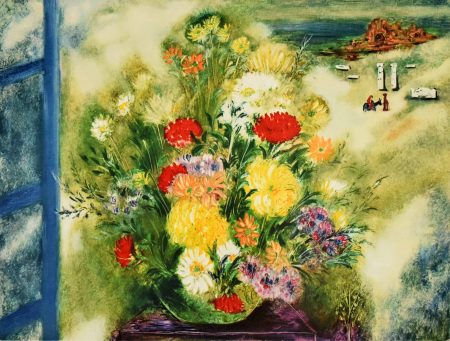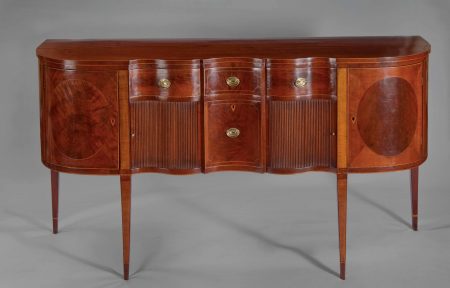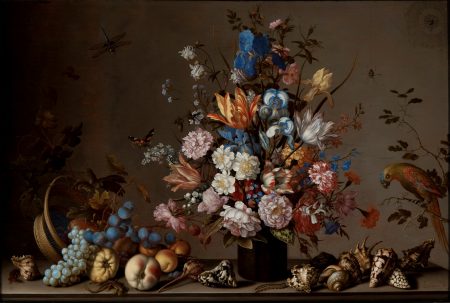What goes into acquiring art institutionally? Aeqai takes a look at the Cincinnati Art Museum and the Skirball Museum at Hebrew Union College – Jewish Institute of Religion.
Cynthia Amneus, curator, fashion arts and textiles at CAM, is an expert in acquisitions which can be gifts or purchases. Sometimes, a curator will receive a call from an unknown person who wants to donate. On the other hand, there are regular collectors such as Allen Bernard who is interested in prints. Some give their collections at one time; others space out the donations, according to Amneus. Relationships are often formed over time and result in contributions.
Amneus said, “As far as purchases, curators are always looking for artwork that fill gaps in our collection. Some come from dealers, others from the other artists themselves, still others are bought at auction.”
The process is to obtain approval from the director whether it be a gift or purchase. Then, the object is brought to the museum. A select number of gifts are presented to the Acquisitions Committee.
With a purchase, the process is more complicated. Once the director approves the purchase, then, arrangements are made by the curators with the dealer or artist. A bid can be placed in person or via the telephone for an auctioned piece. Prior to this, the curator carefully examines the piece viewing the item as well as condition reports. If a dealer is involved, the curator and director often review the piece shipped to the museum. The next step is to present the piece and its details to the Acquisition Committee, which votes to purchase or not.
The final step is to present all gifts and purchases to the Board of Trustees for their approval. So, there are many steps in acquisitions.
What do curators look for? Fill gaps in the collection, find something that is the best of kind and those that make best use of limited acquisition funds, according to Amneus.
“Turning down a gift that is offered is often the hardest part of my job,” said Amneus. “While it may be a great piece, we may already have an example of the work offered in the collection. Most curators will provide a potential donor with a list of other institutions who might be interested in their object.”
Restricted funds play an important part in acquisitions. “These are endowments held by the museum that have been given by donors in the past only to be used for art purchase. The donor has often determined what type of art can be purchased,” said Amneus.
Amneus plays an important role in the acquisition process. “I generally review pieces that curators are interested in bringing into the collection before the curator goes to the director. I am also on the Acquisition Committee and assist in determining the agenda and overseeing the organization of the meetings.”
The other side of the coin is deaccessioning which Amneus describes as complex and not something the museum takes lightly. “If a piece becomes a candidate for deaccession through careful consideration by the curator, it is presented to the director and the Acquisition Committee for approval and then to the Board of Trustees,” Amneus said.
Acquisitions have a great impact on the museum. “You have enriched the lives of Cincinnatians in being able to incorporate this piece into the galleries and share it with the general public. You have also potentially raised the profile of the museum with other institutions. Currently, many of our curators are seeking out acquisitions by women and minorities to strengthen our collection in these areas,” said Amneus.
“Acquiring art can be both exhilarating and heartbreaking,” Amneus said. “We all cheered when we learned we were successful adding a Georgia O’Keeffe painting to the collection. The same can be said for a gift or purchase from a dealer.”
“Curators know what is in town through relationships with donors,” Amneus said. “Sometimes a friend of the museum knows someone who has a collection that we are not aware of and we reach out to them.”
The Harris and Alice Weston collection was bequeathed to the CAM. “It is in the process of bringing the collection to the museum, although the pandemic has slowed that process. Those objects will be fine additions to our collection,” said Amneus.
Significant acquisitions include George Bellows (1882-1925), United States, Artists Judging Works of Art, 1916, lithograph with additional work in black crayon, The James and Lois Sanitato George W. Bellows Collection, 2018.247. The Sanitatos are donating their Bellows print collection to the museum which is planning an exhibition of the work.
Elizabeth Murray (1940-2007) United States, Flesh, Earth and Sky, 1979, oil on canvas. Gift of Ronnie and John Shore 2018.196. This is a major gift of 40 paintings, and the museum is working on an exhibition of these paintings.
Ali Baba Vase 1880 Mary Louise McLaughlin (1847-1939) United States, Cincinnati, earthenware, Gift of the Estate of Jane Gates Todd 2018.142.
Amneus said, “Loans are determined by the importance of the project to which it might be lent; the condition of the piece; the number of loans to be sent out at a particular time.”
Three volunteers Allen W. Bernard, Anu M. Mitra, Ph.D., and Peter Niehoff, Ph.D., have also become involved with the acquisitions program at CAM.
Bernard has been a volunteer in the Print Department for at least 15 years. He is a collector and has donated gifts to the museum for many years. Mitra has served as a docent since 2002 and now is a member of the Board of Trustees. She has chaired the Acquisitions Committee since 2019. Mitra serves on the faculty of the graduate program in Interdisciplinary Studies at the Union Institute and University. They all spoke about acquisitions at the Art Museum. Niehoff was recruited in 2014 to become a non-board committee member. He is a philanthropist, film historian and investor. He sits on the boards of the Cincinnati Country Day School, the Mercantile Library, the UC Health Foundation and Film Cincinnati.
Niehoff said, “Curators and committee members seek to represent art in Cincinnati and the region as well as the world. Gifts are made to us by donors who see the benefit of the museum’s long-term care. After acquisition, each piece is treated the same, no matter how it was acquired.”
The Acquisitions Committee has about a dozen members. According to Anu, all are connected to the museum in long-standing and deeply personal ways. “They have knowledge of and a passion for art, and they bring an ‘outsider’ objective perspective to the work of acquisitions at CAM,” Anu said. She added, “It has been carefully curated to reflect a cross section of society, with its ability to think broadly and deeply. We work beyond our differences in order to imagine a set of values that transcend individual subjectivities, and we translate all of this into our work on the committee.”
In looking for art, Allen said “The museum must strive for excellence in terms of artistic expression. If the object is to be purchased or if it is a possible gift, the provenance is examined along with the reputation of the seller. Certainly, budgetary restrictions must come into consideration. Another paramount consideration is the object’s connection to the local community or region. Yet another consideration is the institution’s need to enrich and exhibit under-represented artists of certain societal groups and periods of artistic expression.”
Recent examples of acquisitions include the purchase of Wind Sculpture IX by Yinka Shonibare, an outdoor sculpture that will welcome visitors in the Sculpture Garden; 20 works on paper from the Indian subcontinent from the Catherine Glynn Benkaim and Ralph Benkaim Collection; and Eleanor Antin’s The King of Solana Beach, 1974-75, gelatin silver print. Allen said a significant acquisition is a recent print by Albrecht Durer from the Apocalypse Series.
Anu said, “I am a collector myself, with a modest collection of contemporary Indian art. Acquiring art and sharing it with others is a pivot that allows each one of us to engage in important and deep conversations on why we are here, what is our place in this universe, what is the role of suffering? Art is eternal – especially that art which we don’t fully understand or that which does not allow us an easy pathway into the narrative construction of the artist.”
Niehoff added, “From a historical point of view, these pieces open a window into the immense timeframe of life and vibrancy of society. These pieces document our past like any text. They represent who we are, while reminding us that as humans we are ever evolving, diverse and empathetic.”
Anu said, “At an institutional level, the art that one acquires must speak to a greater cross section of our fellow human beings, irrespective of class, race and other categorical structures. Acquisitions play a monumental role in setting the agenda for tomorrow. It foresees movements in society and builds a collection that will appeal to our visitors, while also reinforcing our existing collection. The work of acquisitions is nuanced and complex and so many layers have to be considered before a decision is made by the curator and then the chain of command that follows.”
Has the CAM missed out on any collections? Allen said, “The Probasco Collection of Art went to a national auction in New York in the 19th century.”
Although the Taft Museum of Art is unique in that it doesn’t collect art per se, Phillip Long, former director of the Taft, was instrumental in acquiring two works of art for the museum. One was Balthasar Van der Ast’s still life of the 1650’s and a Kentucky sideboard from the 1830’s, both from Cincinnati collections. “If there’s something that makes sense, we ought to consider it,” Long said. The Taft, for example, did not have a Dutch still life.
Long stumbled across both of these pieces while having cocktails with Luther Tucker and Betty Forker respectively. “I wasn’t looking for these objects,” Long said.
Tucker had a Van der Ast given by his mother. It needed some work. The J. Paul Getty Museum agreed to do the work and Tucker agreed to exhibit the piece at the Taft. He died six weeks later, but the piece was given to the Taft. Van der Ast (1593/94 – 1657) was a Dutch golden age painter who specialized in still lifes of flowers and fruits. This one is an excellent example.
At Betty Forker’s house, Long found a cherry sideboard made by Porter Clay, brother of Henry Clay. An article by Ann Glasscock, assistant curator at the Taft, tells the story entitled Solved: The Mystery of the Unknown Cabinetmaker in the Taft’s Portico: “Porter Clay’s sideboard is one of many fashionable works made in Lexington, a booming economic and cultural center once known as ‘the Athens of the West.’”
Long suggested to Forker that she consider giving the sideboard to the Taft. When Forker died, she did. A curator from the Speed Museum was called to view the piece. He said that this was the finest Kentucky sideboard he had seen and if the Taft didn’t want the sideboard, the Speed would be interested. Conservation work was done on it, and it became part of the Taft. Long said it helped put the house back in the Federal look of the 1820’s. “If we can bring something unique to the Taft,” Long said that it would.
Even though he retired from the Taft, “I am always looking for pieces,” Long said. One day at lunch he found a loving goblet with a Longworth engraving at Karp’s auction house. Jay Karp gave the piece to Long who donated it to the Cincinnati Historical Society.
“We’re a Euro-centric collection,” Long said about the Taft. “It’s a remarkable place, but may not be everyone’s cup of tea. We have an obligation to chase excellence.” The Taft underwent a renovation a few years ago. It represents the collection of Anna and Charles Taft.
Long also serves on the Cincinnati Art Museum’s Acquisitions Committee which generally agrees with the curator’s proposals. “CAM asked me to serve because I brought something to the table,” said Long who has a history of service to the community including boards of the Contemporary Arts Center, Cincinnati Arts Association, Cincinnati Symphony Orchestra and Cincinnati Country Day School. “I’ve been involved in Cincinnati because of my professional life – I know a lot of people. It’s important that acquisition members understand the philosophy of the museum – its goals and objectives,” Long added.
According to Abby S. Schwartz, Skirball museum director, the museum does not have an active acquisitions program. “That said, we do accept gifts to the collection and have made one purchase during my tenure as director, through a fund that had been set up by an individual expressly for that purpose,” Schwartz said.
There is a process in place. Skirball follows art management policies established by the American Alliance of Museums. There is an Art Advancement Committee composed of HUC-JIR’s Board of Governors, local Board of Overseers and members of the public who bring specialized expertise to the committee. It depends on the monetary value of the acquisition whether the final decision is made by the committee or by the Board of Governors on recommendation from the committee.
Schwartz said that in looking for art, several criteria are considered: exceptionality of the art, state of preservation of the art, expansion, extension or replacement of a work of art in the existing collection in furtherance of the HUC-JIR mission statement; capacity of being displayed, stored and cared for in accordance with AAM standards and best practices.
Recent acquisitions include 18 prints given by artist Mark Podwal following an exhibition of his work at the Skirball Museum (gift 2018). Ten works by modern Israeli artists came from the collection of Nancy Berman and Alan Bloch (gift 2019).
There are significant acquisitions such as the transfer of the B’nai B’rith Klutznick National Jewish Museum’s collection of art and artifacts which quadrupled the Skirball’s holdings of important Judaica and fine art (gift). According to Schwartz, this made Skirball the largest public collection of Judaica between the Alleghenies and the Rockies.
Another one is the portrait of Marcus Fechheimer by Cincinnati artist John Aubery who also painted the portrait of Rabbi Isaac Mayer Wise, who founded Hebrew Union College, which is in the Skirball Museum’s core collection (purchase).
A third is Holleman Windows, a suite of 11 stained glass windows saved from a synagogue destined for demolition (gift).
Schwartz makes recommendations in consultation with the dean of the Cincinnati campus of HUC-JIR to the Art Advancement Committee. She said, “I am involved every step of the way in bringing recommendations to the necessary bodies.”
There has not been an art deaccession since Schwartz has been director.
Another facet of the museum field is to loan (or not loan) a work of art. Schwartz describes this process. “The Art Advancement Committee advises on the appropriateness of a proposed loan based on restrictions that may be associated with the work of art.” In addition, other considerations are taken into account, such as the historical and scholarly value of making the loan, the impact of the absence of the work, the scope of the loan agreement, and suitability of the institution.
There is a positive impact on acquiring art. Schwartz said, “Bringing important new work into the collection increases the Skirball’s reputation and standing in the museum world…”
Schwartz talks about the importance of being selective when gifts are offered. “This can sometimes be difficult when a work doesn’t meet our criteria, yet is important and of sentimental value to the donor. We also have space constraints and are challenged to find ways to display gifts on a permanent or temporary basis.”
Once art is acquired, Skirball works to display it either through a spotlight exhibition or a dedicated exhibition. Educational programs usually accompany the displays. “We also work to incorporate some acquisitions into our permanent display,” Schwartz said. It may be immediate or take weeks and months to install the art.




